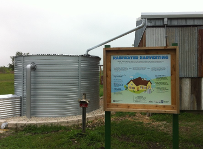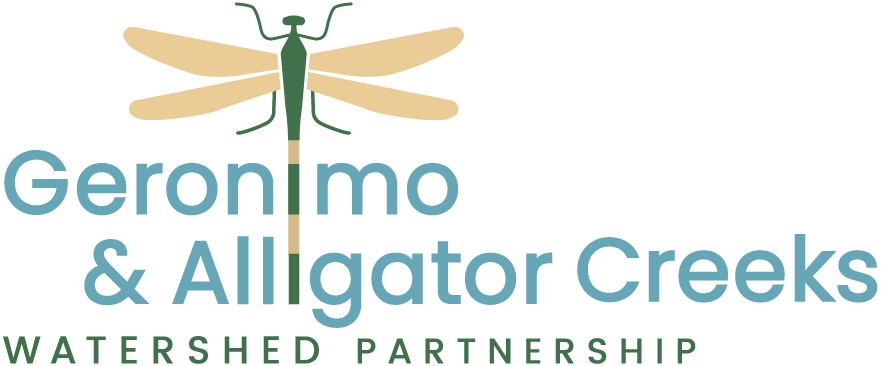The Geronimo Flow
Newsletter of the Geronimo and Alligator Creeks Watershed Partnership
Current edition: January 2025 | Archive
Rainwater Harvesting
- Rainwater Harvesting
- How to Make a Rain Barrel
- Rainwater Harvesting – Presentation from 11/15/16
- Rainwater Harvesting for Livestock
- Rainwater Harvesting – Raingardens
- Texas Rain Garden Plant List
Irma Lewis Sequin Outdoor Learning Center
Rainwater Harvesting at the Irma Lewis Sequin Outdoor Learning Center

The Irma Lewis Outdoor Learning Center provides students, faculty, and the Seguin community with a unique opportunity to explore and learn about nature. This 120+ acre facility features hiking trails winding through woodlands, a pond for fishing and studying aquatic ecosystems, an outdoor classroom, and a garden area.
The Irma Lewis Seguin Outdoor Learning Center installed a rainwater harvesting system to collect rainfall from 1,000 square feet of roof surface and stores it in a 5,000 gallon tank. For each 1 inch of rainfall on the 1,000 square foot catchment area, a little over 600 gallons are collected in the tank.
Community Science through Stream Team
More than 11,000 trained citizen scientists have participated in The Meadows Center’s Texas Stream Team program over the years. Launched in 1991, Texas Stream Team has become one of the longest-running and most successful citizen science program in the nation and is still going strong.
Septic Systems
The Geronimo and Alligator Creeks WPP identified failing septic systems as a potential source of pollution for both bacteria and nitrate nitrogen.
- Understanding and Maintaining Your Septic System
- Responding to Power Outages and Floods
- Operation and Maintenance
- Introduction to Onsite Wastewater Treatment (7MB download)
For more information and free publications about septic systems, visit http://ossf.tamu.edu/.
Agriculture: Farmers and ranchers
Nutrient and bacteria loading from agricultural operations are identified in the Geronimo and Alligator Creeks WPP as potential sources of pollution in area creeks. A site specific WQMP is developed by working with a landowner to identify, design, and implement practices that will protect water resources. The plan includes appropriate land treatment practices, including prescribed grazing, fencing, watering facilities, pipelines, wells, grassed waterways, pasture/hayland/rangeland planting, riparian buffers, filter strips, and others.
Contact:
Guadalupe County NRCS – Sequin Service Center
999 Fleming Drive
Sequin, TX 78155
(830) 379-0930, ext 3
Feral Hogs & Wild Pigs
Feral hogs cause an estimated $52 million of damage to agriculture annually in Texas and they continue to increase in numbers across the state. They like to wallow in stream systems leading to sediment and bacteria entering our waterways.
- Texas A&M AgriLife Extension Publications on Feral Hog Damage, Management, and More
- National Cooperative Extension Resources on Feral Hog Management
- Plum Creek Watershed Partnership Feral Hog Program
Press Releases
Quarterly Reports & Associated Documents
- July – September 2014
Q4 2014 Progress Report
See Archive
